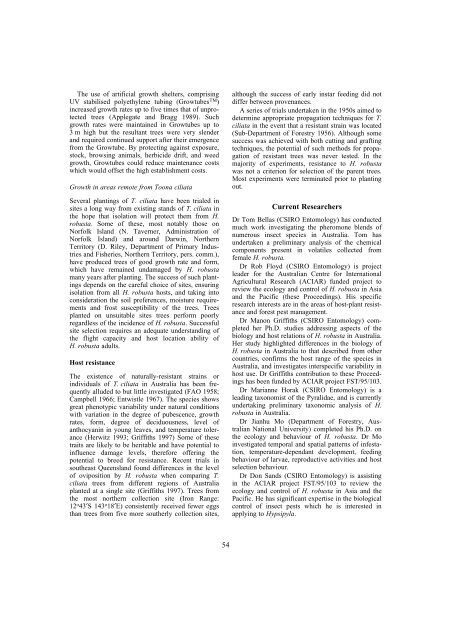Hypsipyla Shoot Borers of Meliaceae in Sri Lanka - Australian ...
Hypsipyla Shoot Borers of Meliaceae in Sri Lanka - Australian ...
Hypsipyla Shoot Borers of Meliaceae in Sri Lanka - Australian ...
You also want an ePaper? Increase the reach of your titles
YUMPU automatically turns print PDFs into web optimized ePapers that Google loves.
The use <strong>of</strong> artificial growth shelters, compris<strong>in</strong>g<br />
UV stabilised polyethylene tub<strong>in</strong>g (Growtubes TM )<br />
<strong>in</strong>creased growth rates up to five times that <strong>of</strong> unprotected<br />
trees (Applegate and Bragg 1989). Such<br />
growth rates were ma<strong>in</strong>ta<strong>in</strong>ed <strong>in</strong> Growtubes up to<br />
3 m high but the resultant trees were very slender<br />
and required cont<strong>in</strong>ued support after their emergence<br />
from the Growtube. By protect<strong>in</strong>g aga<strong>in</strong>st exposure,<br />
stock, brows<strong>in</strong>g animals, herbicide drift, and weed<br />
growth, Growtubes could reduce ma<strong>in</strong>tenance costs<br />
which would <strong>of</strong>fset the high establishment costs.<br />
Growth <strong>in</strong> areas remote from Toona ciliata<br />
Several plant<strong>in</strong>gs <strong>of</strong> T. ciliata have been trialed <strong>in</strong><br />
sites a long way from exist<strong>in</strong>g stands <strong>of</strong> T. ciliata <strong>in</strong><br />
the hope that isolation will protect them from H.<br />
robusta. Some <strong>of</strong> these, most notably those on<br />
Norfolk Island (N. Taverner, Adm<strong>in</strong>istration <strong>of</strong><br />
Norfolk Island) and around Darw<strong>in</strong>, Northern<br />
Territory (D. Riley, Department <strong>of</strong> Primary Industries<br />
and Fisheries, Northern Territory, pers. comm.),<br />
have produced trees <strong>of</strong> good growth rate and form,<br />
which have rema<strong>in</strong>ed undamaged by H. robusta<br />
many years after plant<strong>in</strong>g. The success <strong>of</strong> such plant<strong>in</strong>gs<br />
depends on the careful choice <strong>of</strong> sites, ensur<strong>in</strong>g<br />
isolation from all H. robusta hosts, and tak<strong>in</strong>g <strong>in</strong>to<br />
consideration the soil preferences, moisture requirements<br />
and frost susceptibility <strong>of</strong> the trees. Trees<br />
planted on unsuitable sites trees perform poorly<br />
regardless <strong>of</strong> the <strong>in</strong>cidence <strong>of</strong> H. robusta. Successful<br />
site selection requires an adequate understand<strong>in</strong>g <strong>of</strong><br />
the flight capacity and host location ability <strong>of</strong><br />
H. robusta adults.<br />
Host resistance<br />
The existence <strong>of</strong> naturally-resistant stra<strong>in</strong>s or<br />
<strong>in</strong>dividuals <strong>of</strong> T. ciliata <strong>in</strong> Australia has been frequently<br />
alluded to but little <strong>in</strong>vestigated (FAO 1958;<br />
Campbell 1966; Entwistle 1967). The species shows<br />
great phenotypic variability under natural conditions<br />
with variation <strong>in</strong> the degree <strong>of</strong> pubescence, growth<br />
rates, form, degree <strong>of</strong> deciduousness, level <strong>of</strong><br />
anthocyan<strong>in</strong> <strong>in</strong> young leaves, and temperature tolerance<br />
(Herwitz 1993; Griffiths 1997) Some <strong>of</strong> these<br />
traits are likely to be heritable and have potential to<br />
<strong>in</strong>fluence damage levels, therefore <strong>of</strong>fer<strong>in</strong>g the<br />
potential to breed for resistance. Recent trials <strong>in</strong><br />
southeast Queensland found differences <strong>in</strong> the level<br />
<strong>of</strong> oviposition by H. robusta when compar<strong>in</strong>g T.<br />
ciliata trees from different regions <strong>of</strong> Australia<br />
planted at a s<strong>in</strong>gle site (Griffiths 1997). Trees from<br />
the most northern collection site (Iron Range:<br />
12 o 43′S 143 o 18′E) consistently received fewer eggs<br />
than trees from five more southerly collection sites,<br />
54<br />
although the success <strong>of</strong> early <strong>in</strong>star feed<strong>in</strong>g did not<br />
differ between provenances.<br />
A series <strong>of</strong> trials undertaken <strong>in</strong> the 1950s aimed to<br />
determ<strong>in</strong>e appropriate propagation techniques for T.<br />
ciliata <strong>in</strong> the event that a resistant stra<strong>in</strong> was located<br />
(Sub-Department <strong>of</strong> Forestry 1956). Although some<br />
success was achieved with both cutt<strong>in</strong>g and graft<strong>in</strong>g<br />
techniques, the potential <strong>of</strong> such methods for propagation<br />
<strong>of</strong> resistant trees was never tested. In the<br />
majority <strong>of</strong> experiments, resistance to H. robusta<br />
was not a criterion for selection <strong>of</strong> the parent trees.<br />
Most experiments were term<strong>in</strong>ated prior to plant<strong>in</strong>g<br />
out.<br />
Current Researchers<br />
Dr Tom Bellas (CSIRO Entomology) has conducted<br />
much work <strong>in</strong>vestigat<strong>in</strong>g the pheromone blends <strong>of</strong><br />
numerous <strong>in</strong>sect species <strong>in</strong> Australia. Tom has<br />
undertaken a prelim<strong>in</strong>ary analysis <strong>of</strong> the chemical<br />
components present <strong>in</strong> volatiles collected from<br />
female H. robusta.<br />
Dr Rob Floyd (CSIRO Entomology) is project<br />
leader for the <strong>Australian</strong> Centre for International<br />
Agricultural Research (ACIAR) funded project to<br />
review the ecology and control <strong>of</strong> H. robusta <strong>in</strong> Asia<br />
and the Pacific (these Proceed<strong>in</strong>gs). His specific<br />
research <strong>in</strong>terests are <strong>in</strong> the areas <strong>of</strong> host-plant resistance<br />
and forest pest management.<br />
Dr Manon Griffiths (CSIRO Entomology) completed<br />
her Ph.D. studies address<strong>in</strong>g aspects <strong>of</strong> the<br />
biology and host relations <strong>of</strong> H. robusta <strong>in</strong> Australia.<br />
Her study highlighted differences <strong>in</strong> the biology <strong>of</strong><br />
H. robusta <strong>in</strong> Australia to that described from other<br />
countries, confirms the host range <strong>of</strong> the species <strong>in</strong><br />
Australia, and <strong>in</strong>vestigates <strong>in</strong>terspecific variability <strong>in</strong><br />
host use. Dr Griffiths contribution to these Proceed<strong>in</strong>gs<br />
has been funded by ACIAR project FST/95/103.<br />
Dr Marianne Horak (CSIRO Entomology) is a<br />
lead<strong>in</strong>g taxonomist <strong>of</strong> the Pyralidae, and is currently<br />
undertak<strong>in</strong>g prelim<strong>in</strong>ary taxonomic analysis <strong>of</strong> H.<br />
robusta <strong>in</strong> Australia.<br />
Dr Jianhu Mo (Department <strong>of</strong> Forestry, <strong>Australian</strong><br />
National University) completed his Ph.D. on<br />
the ecology and behaviour <strong>of</strong> H. robusta. Dr Mo<br />
<strong>in</strong>vestigated temporal and spatial patterns <strong>of</strong> <strong>in</strong>festation,<br />
temperature-dependant development, feed<strong>in</strong>g<br />
behaviour <strong>of</strong> larvae, reproductive activities and host<br />
selection behaviour.<br />
Dr Don Sands (CSIRO Entomology) is assist<strong>in</strong>g<br />
<strong>in</strong> the ACIAR project FST/95/103 to review the<br />
ecology and control <strong>of</strong> H. robusta <strong>in</strong> Asia and the<br />
Pacific. He has significant expertise <strong>in</strong> the biological<br />
control <strong>of</strong> <strong>in</strong>sect pests which he is <strong>in</strong>terested <strong>in</strong><br />
apply<strong>in</strong>g to <strong>Hypsipyla</strong>.

















